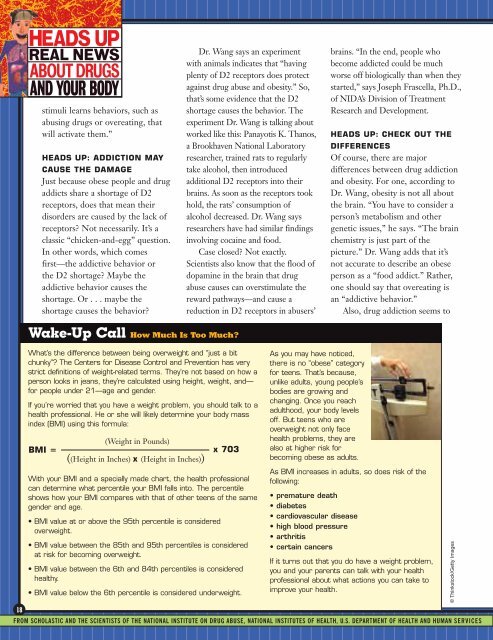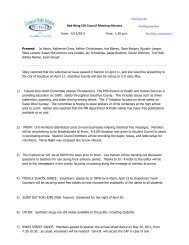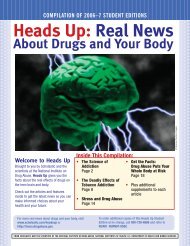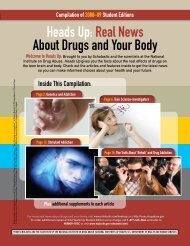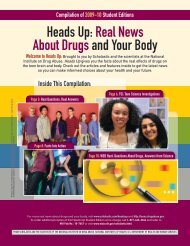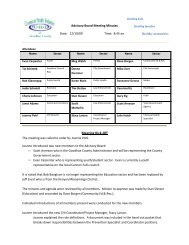Heads Up: Real News About Drugs and Your Body, a ... - Scholastic
Heads Up: Real News About Drugs and Your Body, a ... - Scholastic
Heads Up: Real News About Drugs and Your Body, a ... - Scholastic
Create successful ePaper yourself
Turn your PDF publications into a flip-book with our unique Google optimized e-Paper software.
stimuli learns behaviors, such as<br />
abusing drugs or overeating, that<br />
will activate them.”<br />
HEADS UP: ADDICTION MAY<br />
CAUSE THE DAMAGE<br />
Just because obese people <strong>and</strong> drug<br />
addicts share a shortage of D2<br />
receptors, does that mean their<br />
disorders are caused by the lack of<br />
receptors? Not necessarily. It’s a<br />
classic “chicken-<strong>and</strong>-egg” question.<br />
In other words, which comes<br />
first—the addictive behavior or<br />
the D2 shortage? Maybe the<br />
addictive behavior causes the<br />
shortage. Or . . . maybe the<br />
shortage causes the behavior?<br />
Dr. Wang says an experiment<br />
with animals indicates that “having<br />
plenty of D2 receptors does protect<br />
against drug abuse <strong>and</strong> obesity.” So,<br />
that’s some evidence that the D2<br />
shortage causes the behavior. The<br />
experiment Dr. Wang is talking about<br />
worked like this: Panayotis K. Thanos,<br />
a Brookhaven National Laboratory<br />
researcher, trained rats to regularly<br />
take alcohol, then introduced<br />
additional D2 receptors into their<br />
brains. As soon as the receptors took<br />
hold, the rats’ consumption of<br />
alcohol decreased. Dr. Wang says<br />
researchers have had similar findings<br />
involving cocaine <strong>and</strong> food.<br />
Case closed? Not exactly.<br />
Scientists also know that the flood of<br />
dopamine in the brain that drug<br />
abuse causes can overstimulate the<br />
reward pathways—<strong>and</strong> cause a<br />
reduction in D2 receptors in abusers’<br />
brains. “In the end, people who<br />
become addicted could be much<br />
worse off biologically than when they<br />
started,” says Joseph Frascella, Ph.D.,<br />
of NIDA’s Division of Treatment<br />
Research <strong>and</strong> Development.<br />
HEADS UP: CHECK OUT THE<br />
DIFFERENCES<br />
Of course, there are major<br />
differences between drug addiction<br />
<strong>and</strong> obesity. For one, according to<br />
Dr. Wang, obesity is not all about<br />
the brain. “You have to consider a<br />
person’s metabolism <strong>and</strong> other<br />
genetic issues,” he says. “The brain<br />
chemistry is just part of the<br />
picture.” Dr. Wang adds that it’s<br />
not accurate to describe an obese<br />
person as a “food addict.” Rather,<br />
one should say that overeating is<br />
an “addictive behavior.”<br />
Also, drug addiction seems to<br />
18<br />
Wake-<strong>Up</strong> Call How Much Is Too Much?<br />
What’s the difference between being overweight <strong>and</strong> “just a bit<br />
chunky”? The Centers for Disease Control <strong>and</strong> Prevention has very<br />
strict definitions of weight-related terms. They’re not based on how a<br />
person looks in jeans, they’re calculated using height, weight, <strong>and</strong>—<br />
for people under 21—age <strong>and</strong> gender.<br />
If you’re worried that you have a weight problem, you should talk to a<br />
health professional. He or she will likely determine your body mass<br />
index (BMI) using this formula:<br />
(Weight in Pounds)<br />
BMI = x 703<br />
((Height in Inches) x (Height in Inches))<br />
With your BMI <strong>and</strong> a specially made chart, the health professional<br />
can determine what percentile your BMI falls into. The percentile<br />
shows how your BMI compares with that of other teens of the same<br />
gender <strong>and</strong> age.<br />
• BMI value at or above the 95th percentile is considered<br />
overweight.<br />
• BMI value between the 85th <strong>and</strong> 95th percentiles is considered<br />
at risk for becoming overweight.<br />
• BMI value between the 6th <strong>and</strong> 84th percentiles is considered<br />
healthy.<br />
• BMI value below the 6th percentile is considered underweight.<br />
As you may have noticed,<br />
there is no “obese” category<br />
for teens. That’s because,<br />
unlike adults, young people’s<br />
bodies are growing <strong>and</strong><br />
changing. Once you reach<br />
adulthood, your body levels<br />
off. But teens who are<br />
overweight not only face<br />
health problems, they are<br />
also at higher risk for<br />
becoming obese as adults.<br />
As BMI increases in adults, so does risk of the<br />
following:<br />
• premature death<br />
• diabetes<br />
• cardiovascular disease<br />
• high blood pressure<br />
• arthritis<br />
• certain cancers<br />
If it turns out that you do have a weight problem,<br />
you <strong>and</strong> your parents can talk with your health<br />
professional about what actions you can take to<br />
improve your health.<br />
FROM SCHOLASTIC AND THE SCIENTISTS OF THE NATIONAL INSTITUTE ON DRUG ABUSE, NATIONAL INSTITUTES OF HEALTH, U.S. DEPARTMENT OF HEALTH AND HUMAN SERVICES<br />
© Thinkstock/Getty Images


